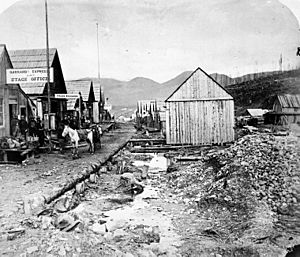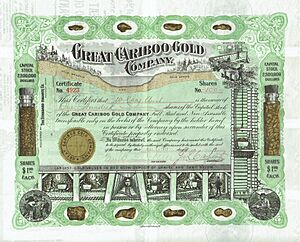Cariboo Gold Rush facts for kids
The Cariboo Gold Rush was a time when many people rushed to find gold in a part of British Columbia, Canada. This happened in the 1860s. The first gold was found in 1858 at a place called Hills Bar. More gold was found in 1859 on the Horsefly River, and in 1860 on Keithley Creek and Antler Creek. The big rush really started in 1861 when news of these gold finds spread widely. By 1865, after more gold was found along Williams Creek, the rush was very busy.
Many towns quickly grew because of the gold rush. The most famous town was Barkerville. Today, Barkerville is a special place where you can visit and see what life was like back then. Other important towns during this time were Keithley Creek, Quesnel Forks, Antler, Richfield, Quesnel, Horsefly, and Alexandria.
Why the Cariboo Gold Rush Was Special
The Cariboo Gold Rush is the most famous gold rush in British Columbia. Some people think it was the reason British Columbia became a colony. But the colony was actually created three years earlier, in 1858, because of the Fraser Canyon Gold Rush. That rush happened in the area from Lillooet to Yale.
The Cariboo Gold Rush was different from the Fraser Canyon rush. Most of the people who came to the Cariboo were from Britain and Canada. About 4,000 Chinese miners also came. The first people to arrive were mostly Americans. But by the time the Cariboo rush began, more people from Britain and Canada were interested in the "Gold Colony," as British Columbia was sometimes called. Many of these people stayed and helped British Columbia join Canada later on.
One reason fewer Americans came to the Cariboo rush might have been the American Civil War. Many American miners went home to fight in the war. Others went to different gold rushes, like the one at Fort Colville or other places in British Columbia.
Some people who came for the Cariboo rush stayed in British Columbia. They became permanent settlers, taking up land in the Interior. This was different from the Fraser rush, where many miners left after the gold was gone. Miners from the Cariboo rush also explored other parts of the province. They helped start new gold rushes, like the Omineca and Cassiar Gold Rushes.
The Cariboo Wagon Road
The gold boom in the Cariboo led to the building of the Cariboo Wagon Road. The Royal Engineers built this road. It was a new way to get to the goldfields. It bypassed older routes through the Fraser Canyon and the Lakes Route. The new road followed the Thompson River to Ashcroft. From there, it went through the Bonaparte River valley to Clinton.
Towns along the Cariboo Road include Clinton, 100 Mile House, and Williams Lake. Many of these towns existed before the gold rush. During the rush, the biggest town was Barkerville, at the end of the road. Barkerville grew around the most famous and profitable mining camps.
Building the Cariboo Wagon Road was very expensive for the colony. But it was important to build it. The road helped the government control the goldfields and the wealth coming from them. This also helped keep the gold from going to the United States.
The road was used to transport gold to Yale. From there, the gold was sent to the government's treasury. Even with all the gold, the cost of building the road and managing the Cariboo region was huge. This high cost caused the mainland colony to almost run out of money. This led to it joining with the island colony, and later, both joined Canada.
In Literature
- Cariboo Road by Alan Sullivan (1946) is a story about a family. They travel from San Francisco to find gold near Williams Creek in 1862.
- Cariboo Runaway by Sandy Frances Duncan (1976) is a book for young adults. It is set in the Cariboo area during the Gold Rush.
See also
 In Spanish: Fiebre del oro de la meseta Cariboo para niños
In Spanish: Fiebre del oro de la meseta Cariboo para niños
- Cariboo camels
- Hudson's Bay Brigade Trail
- Old Cariboo Road
- Omineca Gold Rush
- River Trail






